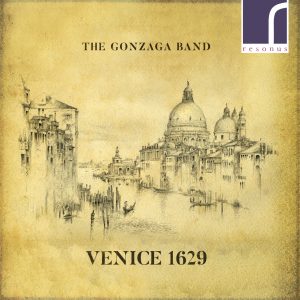 Het Venetië van 1629 is de stad van Heinrich Schütz en vooral van Claudio Monteverdi, die er werkte in de St. Mark Basiliek. Maar in die tijd werd er natuurlijk veel meer muziek geschreven, zowel in Venetië als in de omgeving. Deze met zorg uitgevoerde composities zijn te beluisteren op het album ‘Venice 1629’ door The Gonzaga Band.
Het Venetië van 1629 is de stad van Heinrich Schütz en vooral van Claudio Monteverdi, die er werkte in de St. Mark Basiliek. Maar in die tijd werd er natuurlijk veel meer muziek geschreven, zowel in Venetië als in de omgeving. Deze met zorg uitgevoerde composities zijn te beluisteren op het album ‘Venice 1629’ door The Gonzaga Band.
English version below
The Gonzaga Band bestaat uit drie personen: oprichter, dirigent en cornet-speler Jamie Savan, zangeres Faye Newton en organist/klavecinist Steven Devine. Voor het project ‘Venice 1629’ werden de musici Helen Roberts (cornet), Oliver Webber (viool) en Theresa Caudle (viool/cornet) toegevoegd. De uitvoeringspraktijk van The Gonzaga Band doet enigszins denken aan het legendarische ensemble The Early Music Consert of London dat onder leiding stond van David Munrow en furore maakte begin jaren ’70. Zelfs het repertoire van het destijds uitgebrachte album ‘Monteverdi’s Contemporaries’ (uit 1976) heeft overeenkomsten met ‘Venice 1629’.
Met dezelfde zorgvuldigheid heeft The Gonzaga Band composities bij elkaar gebracht van tijdgenoten van Monteverdi uit het begin van de 17de eeuw. En met dezelfde zorgvuldigheid worden deze schitterend uitgevoerd. Zo heeft zangeres Faye Newton een soepele stem waarmee ze heel gedoseerd gebruik maakt van vibrato, met fraaie versieringen op het einde van een melodische volzin, zoals bijvoorbeeld te horen is in Monteverdi’s ‘Exculta, filia Sion’. Prachtig is ook ‘Maria Virgo’ een vocaal stuk met orgel en cornet-begeleiding. Deze compositie is een wereldpremière net zoals ‘Slava me, salutaris Hostia’ dat werd gecomponeerd door Alessandro Grandi. Een werk met een schitterende interactie tussen viool, cornet en zang. Grandi werd geboren in Venetië en kreeg, net zoals Heinrich Schütz (ook te vinden op deze CD), les van Giovanni Gabrieli. Naast vocaal werk, staan er ook instrumentale stukken op deze wonderlijk mooie CD, zoals ‘Sonata terza’ dat met zijn orkestrale en speelse timbre een prachtige binnenkomer is. Fraai is ook ‘Canzon prima per quattro violini, o cornetti’ met fugatische inzetten en vlijmscherpe toonzetting een mooi geheel vormt, net zoals het slotstuk ‘Sonata decima settima in ecco’ van Dario Castello, met hier en daar virtuoze en bijzondere ‘echo’ (herhalende) passages. ‘Venice 1629’ is een briljant album. Een subliem en luisterrijk document waarop The Gonzaga Band het Venetië van begin 17de eeuw voortreffelijk laat herleven. Je zou er zo naar terug willen.
English version
Venice 1629 was the city of Heinrich Schütz and especially Claudio Monteverdi, who worked at this wonderful city in the St. Mark Basilica. But at that time, of course, much more music was written, both in Venice and in the surrounding area. Some of these great compositions are performed on the album ‘Venice 1629’ by the ensemble The Gonzaga Band.
The Gonzaga Band consists of three people: founder, conductor and cornet player Jamie Savan, singer Faye Newton and organist / harpsichordist Steven Devine. For the project ‘Venice 1629’, the musicians Helen Roberts (cornet), Oliver Webber (violin) and Theresa Caudle (violin / cornet) were added. The performance practice of The Gonzaga Band is reminiscent of the legendary ensemble The Early Music Consert of London, led by the great David Munrow and was popular in the early 70s. Even the repertoire of the their released album ‘Monteverdi’s Contemporaries’ (from 1976) has similarities with ‘Venice 1629’.
Also The Gonzaga Band compiled compositions of Monteverdi contemporaries from the beginning of the 17th century. And they are performed with the same precision. For example, vocalist Faye Newton has a smooth voice with a fine slow vibrato, with beautiful ornaments at the end of a melodic sentence, as can be heard in Monteverdi’s ‘Exculta, filia Sion’. Also beautifully is the vocal piece ‘Maria Virgo’ with organ and cornet accompaniment. This piece is a world premiere like ‘Slava me, salutaris Hostia’ that was composed by Alessandro Grandi. A composition with a beautiful interaction between violin, cornet and vocals. Grandi was born in Venice and, like Heinrich Schütz (also on this CD), he was taught by the excellent composer Giovanni Gabrieli. Besides vocal work, there are also instrumental pieces on this wonderful CD, such as ‘Sonata terza’, with an almost orchestral timbre, a beautiful entry of the album. Fine is also the fugatic piece ‘Canzon prima per quattro violini, o cornetti’ . Excellent performed, just like the final piece ‘Sonata decima settima in ecco’ by Dario Castello with some virtuoso parts and special ‘echo’ (repeating ) passages. ‘Venice 1629’ is a brilliant album. A sublime and glorious document on which The Gonzaga Band revives the Venice of the beginning of the 17th century. It makes you feel going back.
- The Gonzaga Band: ‘Venice 1629’ (Resonus Records)
© Mattie Poels.

Geen reacties